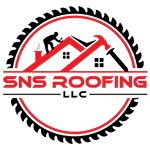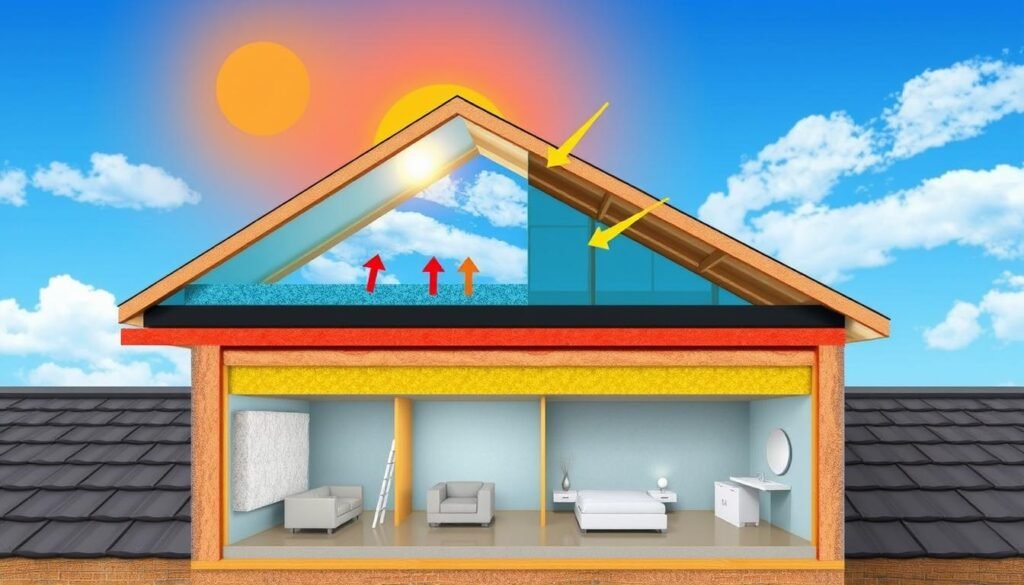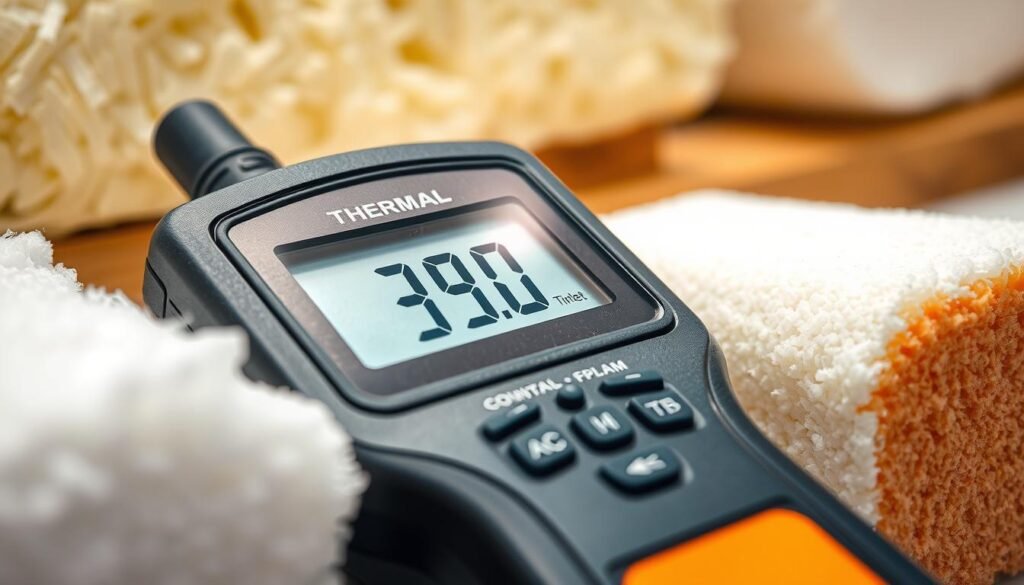Ever wondered why your attic feels like a sauna in summer and an icebox in winter? The answer lies in the intricate science of roof insulation. This crucial component of your home’s structure plays a pivotal role in maintaining comfort and energy efficiency year-round.

Roof insulation is your home’s thermal defense system. It acts as a barrier, regulating heat flow between your living space and the outside world. By understanding the principles behind this technology, you can make informed decisions to boost your home’s energy savings and overall comfort.
The effectiveness of insulation is measured by its thermal resistance, commonly known as the R-value. This metric indicates how well a material resists heat transfer. The higher the R-value, the better the insulation performs. But there’s more to the story than just numbers.
Different types of insulation materials offer unique benefits. Fiberglass batts, foam boards, and spray foam each have their strengths in combating heat transfer. Some even incorporate reflective or radiant barriers to tackle the scorching summer heat head-on.
Proper roof insulation doesn’t just keep you cozy; it’s a game-changer for your wallet and the planet. By minimizing heat transfer, you’ll see lower energy bills and reduced wear on your HVAC system. Plus, you’ll be doing your part to shrink your carbon footprint.
Key Takeaways
- Roof insulation regulates heat flow, enhancing home comfort
- R-value measures insulation’s thermal resistance effectiveness
- Various insulation types offer different benefits and applications
- Proper insulation leads to significant energy savings
- Insulated homes have increased property value and environmental benefits
Understanding Heat Transfer in Roofing Systems
Heat transfer in roofing systems is key to keeping your home comfy and energy-efficient. Your attic insulation fights off three main heat transfer types: conduction, convection, and radiation.
Conductive Heat Flow and R-Values
Conductive heat flow happens when heat moves through solid stuff. Insulation’s R-value shows how well it blocks this heat. The higher the R-value, the better the insulation.
Fiberglass, foam, and cellulose are top picks for attic insulation. They have high R-values.
Convection Patterns in Roof Spaces
Convection is about heat moving through air. Good attic insulation cuts down air movement. This stops convection patterns that let heat in and out.
This helps keep your home’s temperature steady. It also eases the load on your HVAC system.
Radiant Heat Transfer and Reflective Barriers
Radiant heat transfer uses electromagnetic waves. Some insulations have reflective surfaces. These surfaces block radiant heat from entering or leaving your home.
This is great for places with lots of sun. It can really cut down on cooling costs.
| Heat Transfer Type | Insulation Solution | Benefit |
|---|---|---|
| Conductive | High R-value materials | Resistance to heat flow |
| Convective | Air-trapping insulation | Reduced air movement |
| Radiant | Reflective barriers | Heat reflection |
The Fundamentals of Thermal Resistance
Thermal resistance is key in roof insulation. Knowing about it helps you choose the right insulation for your home.
Defining R-Values and Their Importance
R-value shows how well a material stops heat from moving. It’s a key measure of how well insulation works. Higher R-values mean better insulation. In Atlantico, Colombia, roofs need R-15 to R-30 insulation.
Factors Affecting Thermal Resistance
Many things affect insulation’s thermal resistance. These include the material, its thickness, density, and how it’s installed. For example, fiberglass is popular because it has a high R-value and low heat transfer. Foam board is great for insulation and keeps moisture out.
Calculating Total Thermal Resistance
To find the total thermal resistance, add the R-values of each layer. Remember, R-values add up. For example, using R-21 faced fiberglass batts with other insulation increases the total resistance. The U-factor, which is the inverse of R-value, shows the overall heat transfer.
| Insulation Type | R-Value Range | Key Properties |
|---|---|---|
| Fiberglass | 2.2 – 2.7 per inch | Affordable, effective |
| Foam Board | 3.6 – 6.5 per inch | High insulation, moisture-resistant |
| Mineral Wool | 3.0 – 3.3 per inch | Fire-resistant, soundproof |
Types of Roof Insulation
Roof insulation is key to keeping your home energy-efficient. Each material has its own benefits, helping you pick the best for your home.
Fiberglass insulation is a favorite because it’s affordable. It’s simple to put in and keeps your home warm or cool well. Foam boards are great for small spaces. They insulate well and keep moisture out.
Cellulose insulation is made from recycled paper and is good for the planet. It’s treated to prevent fires and can fill tight spots. Spray foam expands to block heat and air leaks, making it a strong choice.
| Insulation Type | Cost per Square Foot | R-Value per Inch |
|---|---|---|
| Fiberglass Batt | $1.00 – $1.50 | R-2.9 – R-3.8 |
| Spray Foam | $1.00 – $2.00 | R-3.6 – R-3.9 |
| Polyisocyanurate Boards | $0.65 – $0.85 | R-6.5 – R-8.0 |
| Blown-In Cellulose | $0.50 – $2.50 | R-3.2 – R-4.0 |
Think about your climate, roof type, and budget when picking insulation. Good insulation can cut heat loss by up to 35% in winter. It also lowers heat gain in summer.
Measuring Insulation Performance
Insulation is key to keeping buildings energy-efficient. Experts use different ways to check how well insulation works.
Lambda Values and Testing Standards
Lambda values show how well insulation materials keep heat in. These values come from strict tests to make sure all products are the same. The lambda 90/90 value means 90% of the product meets the thermal conductivity with 90% confidence.
Thermal Conductivity Measurements
Thermal conductivity, or K-value, shows how well a material stops heat from passing through. The lower the value, the better the insulation. For example, spray foam insulation has a value of 0.023-0.026 W/mK. Fiberglass is a bit worse, with values from 0.030-0.044 W/mK.
U-Value Calculations and Applications
U-values show how much heat a building loses. To find U-values, you look at the thermal resistance of materials and air spaces. A lower U-value means better insulation.
| Insulation Type | R-Value per Inch | Thermal Conductivity (W/mK) |
|---|---|---|
| Closed-cell Spray Foam | 6.0 – 7.0 | 0.023 – 0.026 |
| Fiberglass | 2.2 – 4.3 | 0.030 – 0.044 |
| Cellulose | 3.2 – 3.8 | 0.039 – 0.042 |
Knowing these details helps you pick the best insulation for your home. But remember, how well it works also depends on how it’s installed.
The Impact of Proper Roof Insulation
Proper roof insulation is key to better home comfort and energy use. Let’s look at the main benefits of a well-insulated roof. It can make your living space much better.
Energy Efficiency Benefits
Good roof insulation changes the game for energy use. It can cut your energy bills by up to 30%. This big saving comes from your HVAC system working less hard.
A well-insulated roof keeps heat out in winter and in summer. This lets your heating and cooling systems work better. They don’t have to work as hard, saving you money.
Temperature Regulation Effects
Proper roof insulation helps keep your home’s temperature steady. It can cut energy use for temperature control by up to 50%. This means your home stays cozy in winter and cool in summer.
Your HVAC system won’t have to work as hard. This makes your home more comfortable and saves you money on bills.
Moisture Control Advantages
Roof insulation does more than just control temperature; it also controls moisture. It stops condensation, which lowers the risk of mold and damage. This is vital for a healthy home and a strong roof.
Investing in good roof insulation brings big benefits over time. It improves your home’s comfort and saves energy. You could save hundreds or thousands of dollars each year on heating and cooling. So, proper roof insulation is a wise choice for homeowners.
Installation Considerations and Best Practices
Proper insulation installation is crucial for energy efficiency in your home. Think about air sealing and moisture control when planning. The insulation amount needed depends on your climate, heating and cooling, and the area you’re insulating.
Before starting, check local building codes for compliance. Professional installation can prevent issues like air gaps and thermal bridging. For DIY, use the right tools. ROCKWOOL suggests serrated knives or reciprocating blades for clean cuts and less waste.
When adding multiple layers, stagger joints by at least 6 inches. Use 4 fasteners per board for fastening. Adhesive applications might need 4 or 11 beads, depending on the situation. Regular checks and maintenance keep insulation working well over time.
ROCKWOOL has a variety of products for different needs, like Toprock ® DD and Multifix ™ series for roofing. These aim to protect your roof, cut energy use, and boost ROI. Prices range from $0.50 to $3.00 per square foot, so you can find something that fits your budget and needs.
Source Links
- The Science Behind Roof Insulation: How It Affects Your Home’s Comfort – Affordable Roofing | Scottsdale, AZ | Kore Roofing – https://www.koreroofing.com/the-science-behind-roof-insulation-how-it-affects-your-homes-comfort/
- The Science of Insulation Explained | Knauf Insulation Australia – https://knauf.com/en-AU/knauf-insulation/competencies/expertise/energy-efficiency/tips-to-keep-warm/science-of-insulation-explained
- The Thermodynamics of Thermal Insulation – CCPIA – https://ccpia.org/the-thermodynamics-of-thermal-insulation/
- The Science Behind Roofing Insulation and Energy Savings -BlackStorm – https://blackstormroofingmarketing.com/the-science-behind-roofing-insulation-and-energy-savings/
- The Science of Heat Transfer: How Insulation Impacts Roofing and Energy Usage – https://davisroofingsolutions.com/blog/the-science-of-heat-transfer-how-insulation-impacts-roofing-and-energy-usage/
- Understanding the Science Behind Quality Roof Insulation – https://regan-roofing.com/blog/roof-repair-services/understanding-the-science-behind-quality-roof-insulation-a-focus-on-regan-roofing/
- Thermal Insulation – What It Is? How Does It Work? – https://thermtest.com/thermal-insulation-what-is-it-and-how-is-it-used
- R-value (insulation) – https://en.wikipedia.org/wiki/R-value_(insulation)
- Roof Insulation: Types & Recommendations – https://www.insulation4less.com/roof-insulation?srsltid=AfmBOor2Cv-5cJzDAxhwx265BEWmVW4T5iuaJPPWFMPLVNZ8cdPpsynV
- 8 Common Types Of Roof Insulation & Their Features (Updated) – https://roofingkettering.com/blogs/roof-insulation/
- Types of Insulation – https://www.energy.gov/energysaver/types-insulation
- Insulation – https://www.energy.gov/energysaver/insulation
- All About Insulation R-Values – https://www.homedepot.com/c/ab/insulation-r-values/9ba683603be9fa5395fab9091a9131f
- Insulation R Value: How To Choose the Right Insulation – https://www.greenattic.com/blogs/insulation-r-value-how-to-choosing-the-right-insulation?srsltid=AfmBOoo1T9AMheXOaYtOi8EvrQUc6MGY09kN9ZcJf250qMfn6wb7T5x5
- The Importance of Roof Insulation: Save Energy and Lower Costs – https://www.cenvarroofing.com/roofing-blog/the-importance-of-proper-roof-insulation-for-energy-savings
- The Importance of Proper Roof Insulation for Energy Savings – https://www.tessonroofing.com/the-importance-of-proper-roof-insulation-for-energy-savings
- A Guide To Roof Insulation: What Materials Are The Best? – https://mccormickrenovationpgh.com/blog/roof-insulation/
- PDF – https://www.rockwool.com/siteassets/o2-rockwool/documentation/technical-guides/commercial-roofing/roofing-installation-guide—technical-guide.pdf



0 Comments